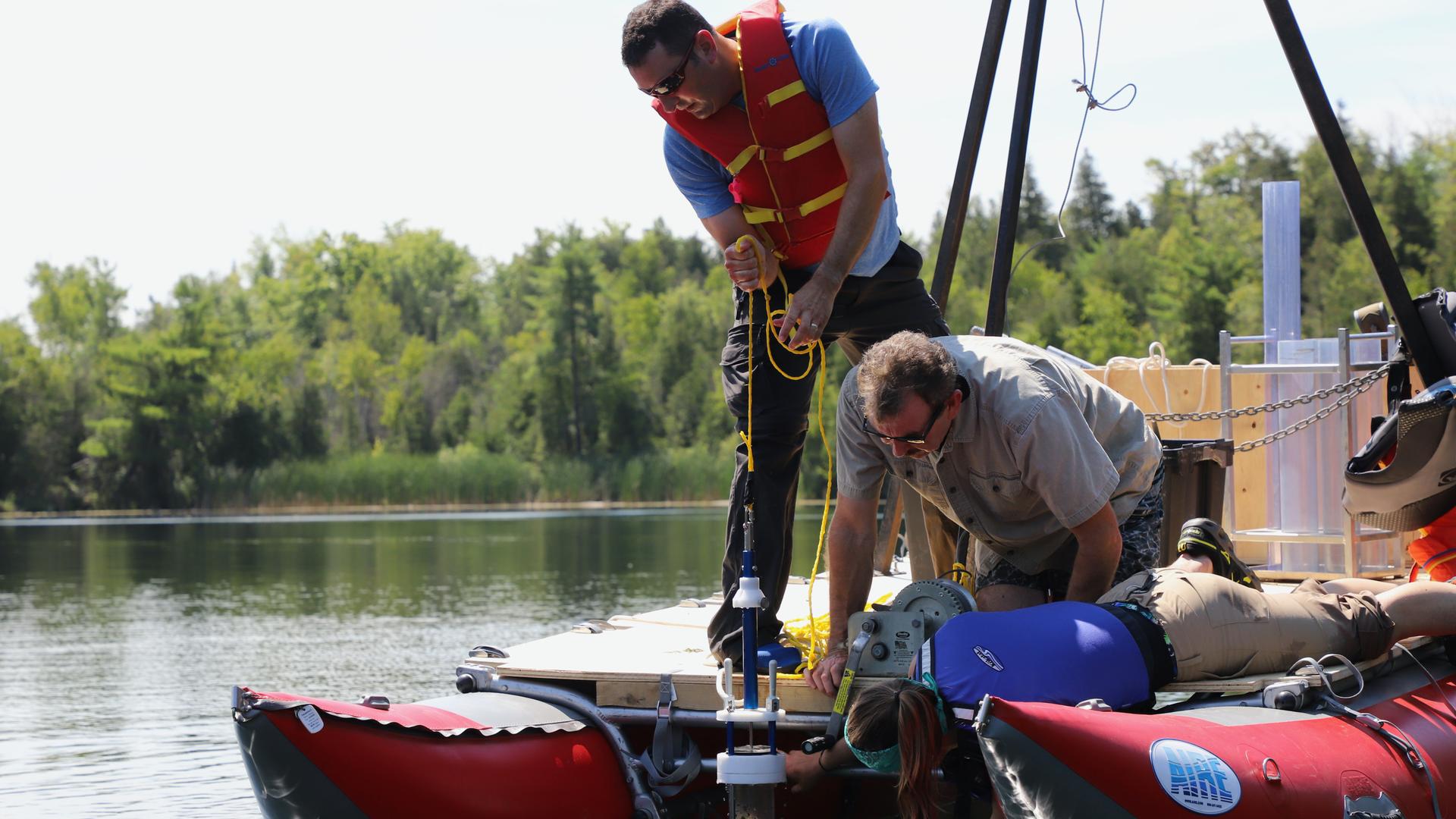Geologists edge closer to defining the Anthropocene
Mike Pisaric, Tim Patterson and another Team Crawford member pull a core sample from the bottom of Crawford Lake in Ontario, Canada.
For human beings, Earth is a supremely human place. A world of concrete, steel, glass, plastic, cars, paved streets and highways, and lots of other human beings, generating mountains of waste. Here and there, pockets of nature for human beings.
Dutch chemist Paul Crützen coined a term for Earth’s human age — the Anthropocene. Crützen proposed that it be declared a new epoch in Earth history, terminating the one geologists say we’ve been in for the past 12,000 years, the Holocene.
This summer, a scientific panel will shift Crützen’s proposal up a notch.
The Anthropocene Working Group (AWG) was set up in 2009 by a commission of the International Union of Geological Sciences. Its task — defining the Anthropocene, geologically.
Crützen’s idea was that the Anthropocene began with the 18th-century Industrial Revolution. In 2019, a decade of research under its belt, the AWG decided it actually began around 1950, at the start of what American environmental historian John McNeill dubbed the Great Acceleration, in the wake of World War II; a period marked by massive fossil-fuel burning, resource extraction, pollution, global trade and population growth, and the parallel rise of atmospheric carbon dioxide, surface temperature, biosphere degradation and so on.
The AWG’s next task was to identify one spot on Earth where the telltale signs of human activity are best observed in mid-20th-century sediments. The technical term for this is a mouthful — a Global Stratotype Section and Point. The more popular one: a “Golden Spike.”
To be precise, that Golden Spike would be the thin sequence of layers in a core pulled from the bottom sediments of a lake, bay or estuary, or from a peat bog, ice sheet, coral reef or stalagmite, somewhere on Earth, containing the chemical and material signatures of human activity dating to the mid-20th century. Key among these — spheroidal carbonaceous particles (fly ash) from coal burning, microplastics, heavy metals, isotopes of carbon and nitrogen associated with fossil fuel burning, and radioactive Plutonium-239 from atmospheric nuclear weapons testing that peaked in the 1950s.
After years of investigation, the AWG came up with a list of 12 candidate Golden Spikes — in Japan, China, Canada, the US, Denmark, Italy, Poland, Australia and the Antarctic. Each candidate site assembled a scientific team to study their cores in the minutest detail.
Francine McCarthy, lead scientist for Crawford Lake, in southern Ontario, is proud of her sedimentary cores.
“We do have the best site,” McCarthy said. “I have to accept some kind of maternal pride.”
McCarthy has reason to be proud. Crawford Lake has been recording human activities for thousands of years. That’s because it’s very deep, and its bottom sediments are permanently isolated. Those sediments consist of many layers, laid down year after year, all precisely dated.
They record the history of coal burning, the rise of atmospheric carbon dioxide and atmospheric nuclear weapons tests, all peaking around 1950.
So do sediments from the Baltic Sea, Japan’s Beppu Bay, Sihailongwan crater lake in China and the Śnieżka peat bog at the heart of Poland’s polluted “Black Triangle.” San Francisco Bay estuary cores are rich in invasive species, mercury and SCPs. Coral samples from the Gulf of Mexico and Cairns, Australia, are also competitive.
The competition is tense. To be chosen as the Anthropocene’s Golden Spike, a candidate site must receive 60% of votes from the AWG’s 23 voting members. Multiple rounds of voting have taken place over the past year.
As the AWG prepares to announce its choice, prominent geologists disagree that the Holocene Epoch ended, and the Anthropocene began, a mere 70 years ago.
“In geological terms, that’s today. It’s just yesterday morning,” said Phil Gibbard, a geologist at Cambridge University. ”We have no clue about, seen from thousands of years in the future, whether this would be more than a blip.”
Only time will tell if the Anthropocene is a blip, said Simon Turner, AWG’s secretary. Turner, standing in a hallway at University College London, around the corner from the geology department, reflects on the popularity of the Anthropocene idea in nonscientific circles.
“The thing with the Anthropocene, people get it,” Turner said. “They get the idea of, like, human activity on the planet. The Holocene … I can probably pull someone over here now and say, ‘have you heard of the Holocene?’ And they will not have heard of it … and geology is just down the corner, so you would hope someone has.”
The Anthropocene Working Group will announce its winning Golden Spike sometime this summer, or in the early fall, in Berlin. Its proposal will then pass up the geo-bureaucratic hierarchy — first to the Subcommission on Quaternary Stratigraphy, then the International Commission on Stratigraphy and finally, the International Union of Geological Sciences.
However, approval of that Golden Spike — either as the base of a new epoch, the Anthropocene, or just the latest stage of the Holocene (in which case, it would be named after its Golden Spike; the Crawfordian, for instance) — could take years.
